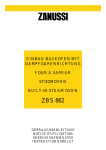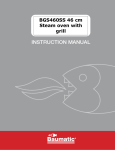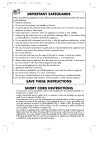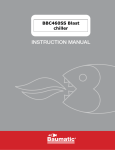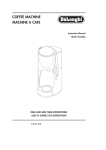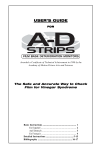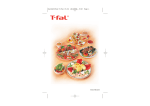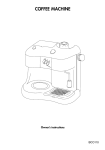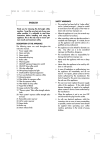Download KitchenAid 6610 Convection Oven User Manual
Transcript
KOSS 6610 Product sheet Product description 4 Accessories 5 Control panel 5 Description of the control panel 6 Using the oven for the first time 6 Settings 6 Resetting the language 7 Showroom Mode 7 Safety Characteristics 8 Timer 9 Special Functions 10 Professional Functions 11 Oven functions table 12 Table for Dual - left - turbogrill cooking 13 Table for Static and Fan cooking 14 Professional and special cooking table 16 Cleaning 17 Steam cooking function 18 Steam cooking table 19 Using the heat probe 20 Filling/emptying of the water 21 Steamer 22 Product description 1. 2. 3. 4. 5. 6. 7. 8. 9. 10. 11. 12. 13. Control panel Water filling drawer Cooling fan (not visible) The fan may continue to operate even after you have turned the appliance off. This helps the oven to cool down. Water emptying nozzle Top shelf Grill protector Middle shelf This prevents direct contact with the grill. Bottom shelf We strongly recommend that the grill and its protector is not touched as this will become hot during operation Grill element Steam injection tube Heat probe plug Light Circular element (not visible) Oven fan Lower element (not visible) Cool oven door 4 ! § ) Q = E " $ % & / ( W Accessories Baking tray Wire shelf Pan Set Steamer Dehydration rack Control panel 5 1. 2. 3. 4. On/Off – Function Selection control knob Cancel selection or return to previous selection button Confirmation button Control knob for changing predefined levels (temperature/time/levels) and moving from one function to another. 5. Water filling drawer When you have finished cooking, turn the control knob to 0. 5 Description of the control panel The Functions selection control knob is used to select the different oven functions. Each turn of the control knob corresponds with a function: Turn the F control knob four clicks anticlockwise. The word SETTINGS appears. By pressing the cancellation button “<<”, you can cancel the set operation and return to the previous display. Once the required setting appears, highlighted in the display, you can confirm by pressing the “OK” button and move on to the next programming stage. Depending on the selected function, the navigation control knob “-/+” has different uses: • To navigate between the menus and sub-menus. • To increase/reduce the levels indicated. • To navigate between the cooking functions. • To increase/reduce cooking time and temperature. First use The first time the oven is switched on the user will be asked to enter the following settings: • • • • Language Brightness Sharpness The time under the ‘Clock’ setting Enter the desired values using the “-/+” control knob then confirm by pressing the "OK" button. Settings Turn the function control button five clicks to the left. The following message appears: SETTINGS -/+ TO CHANGE In sequence, it is possible to set: • LANGUAGE (Available languages: ENGLISH (factory setting), GERMAN, FRENCH, ITALIAN, SPANISH, DUTCH, SWEDISH, NORWEGIAN, DANISH, FINNISH). • CLOCK • ALARM • SHARPNESS • BRIGHTNESS Reset brightness and sharpness settings. To reset brightness and sharpness to factory settings: Turn the F control knob to “0”. Turn the F control knob to settings. Keep the OK control button pressed for 5 seconds. This will revert the appliance to the factory settings. 6 Resetting the language To change a wrongly set language, proceed as follows: 1. Set the Functions control knob to the “SETTINGS” position, rotate to “Language” and confirm by pressing “OK”. 2. Select the required language using the “-/+” control knob and confirm the choice by pressing “OK”. Showroom mode If the word “KitchenAid” appears on the display, the oven is in the Showroom or demonstration mode and the oven elements will not heat up. To exit the demonstration mode and return to the normal operation mode of the oven proceed as follows: 1. Unplug then reconnect the oven from the mains within 60 seconds: 2. Rotate the On/Off – Functions Selection control button to “Rapid preheating” position 3. Press the “<<” button 4. Rotate the On/Off – Functions Selection control button to “0” position 5. Press the “OK” button. Do the same to enter the showroom mode sequence. 7 Safety Characteristics Child safety control panel lock. To turn the “child safety” device on or off: Simultaneously press the “<<” and “OK” buttons for at least 5 seconds. If turned on, the Function control knob and push buttons are locked and the display. Note: This function can be activated when you are cooking. icon appears on the Automatic turn off device For safety purposes, the oven will automatically turn off after 4h 30 mins of continuous running (except for Special Functions). Request for confirmation when the settings are changed Bringing the control knob back to the original position, the display will once again show the current cooking settings. In any case, until the user confirms their desire to change the settings, the oven continues with the cooking. If the Functions control knob is rotated during cooking, the oven asks for confirmation of this choice in order to prevent accidentally changing the cooking settings. Stand by To save energy you can turn the display off (OFF display method) by pressing the “<<” button with the Functions control knob in the “0” position. To make the display visible again, press the “<<” key again with the Functions control knob in the “0” position. 8 Timer The timer can only be used when the oven is not on and allows you to set a maximum time of 3 hours and 59 minutes. To set the timer: 1. Keep the Functions control knob in the “0” position. 2. By turning the “+/-” control knob, the flashing word “TIMER” appears. 3. Turn the “+/-” control knob to set the required time. 4. Press the “OK” key to confirm the setting and activate the timer. The timer starts to run down; when the set time runs out a signal is heard and the word “END” appears on the display. By pressing the “OK” button for confirmation, the timer function turns off and the present time appears on the display. The timer can, however, be turned off at any time by pressing the “<<” button twice. Select the cooking duration/delayed start (with the exception of the professional functions and steam cooking functions with heat probe in): The cooking time allows the oven to work for a set period. The maximum cooking time that can be programmed is 3 hours and 59 minutes. Once the cooking has started, you can set the cooking time by pressing the “OK” button. The flashing symbol appears on the display. 1. Turn the “+/-” control knob until the required cooking time appears. Confirm by pressing “OK”. 2. At this stage you can set the end of the cooking so that the dish is ready at the required time. 3. By pressing the “OK” control knob, the flashing symbol appears on the display. 4. Turn the “+/-” control knob until the required cooking end time appears. 9 Special Functions • KEEPING WARM Keeps cooked food hot. The oven will maintain a constant temperature of 60°C. It is best to use the bottom shelf position. Both the end and duration of the function can be set. • DEFROST To defrost food at room temperature. Leave the food in its packaging to prevent it drying out. • DOUGH PROVING Recommended for proving of pasta, bred and pizza dough. • DRIED FRUITS To dry any kind of fruit. Use the dehydration rack, if provided, or a steel net with small holes, positioned over the wire shelf provided, in order to allow the air flow and prevent small pieces of food falling as it gradually reduces in size while drying out. • DRIED VEGETABLES To dry any kind of vegetable. Use the dehydration rack, if provided, or a steel net with small holes, positioned over the wire shelf provided, in order to allow the air flow and prevent small pieces of food falling as it gradually reduces in size while drying out. • DRIED MUSHROOMS To dry mushrooms and preserve them for storage. Use the dehydration rack, if provided, or a steel net with small holes, positioned over the wire shelf provided, in order to allow the air flow and prevent small pieces of food falling as it gradually reduces in size while drying out. • YOGHURT To prepare homemade yoghurt (see Recipes). It is best to use a ceramic dish with ceramic or tempered glass lid, not a plastic one. • SLOW MEAT To delicately cook meat for the best results. • SLOW COOKING FISH To delicately cook fish for the best results. • SABBATH This is a function dedicated to the prolonged cooking of recipes (see Recipes). N.B. It is best not to interrupt cooking that requires you to insert the food into a cold oven, or an oven that is on a very low operating temperature as the oven will try to restart the cooking from the beginning and will wait until the temperature in the oven has returned to room temperature. If the cooking should be interrupted and you cannot wait for the oven to cool down we advise that you should restart the cooking process using the STATIC function and by setting a suitable temperature (see the cooking table). 10 Professional Functions By positioning the “Functions Selection” control knob on one of professional functions “PRO”, you will be able to access the preset professional cooking functions. You can select the recipe you want from among the 11 memorised recipes using the “+/-” control knob. Press “OK” to select the function and start cooking. Consult the Recipes for information on the use of these functions. The available functions are shown below. The cooking times and temperatures of each function are showing the following tables. Professional bread making functions Tradit. Bread Malt bread Pan pizza Thin pizza Focaccia Bread Sticks Professional cake baking functions Choux Pastry Croissant Sponge cake Plum cake Short pastry 11 Oven functions table Function Pre-set temperature Adjustable temperature Function description Rapid heating 200°C 50°C - 250°C To pre-heat the oven quickly. When the set temperature is reached, the function automatically turns off and a signal is emitted to indicate the automatic change of the oven to STATIC function. Recommended when cooking meat, fish and poultry. Static 200°C 50°C - 250°C Suitable for all kinds of foods. Pre-heat the oven to the required temperature and put in the food when the signal sounds indicating the oven is now at the required temperature. This function is ideal for cooking large pieces of meat (roast beef, roast joints) and for making toast. This function activates the entire top grill element. This function can be set to different power levels (min. 1 - max. 5). The default position is (3). Pre-heat the oven for 5 min. with the door closed. For best results, leave the oven door open when grilling. Arrange food on the wire shelf. When cooking meat, to avoid spatters of fat and smoke, pour a little water into the drip tray. Ideally the meat should be turned during cooking. Dual grill Left grill Turbogrill 3 1-5 To cook small pieces of meat (smoked bacon, steaks, sausages, etc.) and for making toast. This function activates the left side of the upper grill element only. Pre-heat the oven for 5 min. with the door closed. For best results, leave the oven door open when grilling. Arrange food on the wire shelf. When cooking meat, to avoid spatters of fat and smoke, pour a little water into the drip tray. Turn the food during grilling. To grill large pieces of meat (roast beef, roasts). The TURBOGRILL function can be adjusted from 1 to 5 for different levels of heat. Pre-heat the oven for 3-5 mins. The oven door must stay shut when cooking. When cooking meat, pour a little water into a drip tray placed on the bottom shelf, to reduce the smoke and fat splatters. You should turn the meat when cooking. Air heated 160°C 50°C - 250°C To cook the food that requires the same cooking temperature without preheating, on one or more shelves (e.g.: fish, vegetables, cakes). Special functions See the programme sheet (below). Settings See the programme sheet (below). Cleaning See the programme sheet (below). Professional bread baking function See the programme sheet (below). Professional cake baking function See the programme sheet (below). Steam cooking function See the programme sheet (below). 12 Table for Dual - left - turbogrill cooking FOOD Function (from the bottom) Shelf position Heat Level (Max) Cooking time (minutes) Steaks 3 5 30 - 40 Cutlets 3 5 30 - 40 Sausages 3 5 30 - 40 Chops 3 5 35 - 45 Fish (slices) 3 5 30 - 40 Chicken thighs 3 5 40 - 50 Kebabs 3 5 35 - 45 Small ribs 3 5 35 - 45 Bacon rasher 3 5 5 - 10 Note: when using the left grill cooking time should be increased. FOOD Function Pre-heating (5 minutes) Shelf position Heat Level (from the bottom) (Max) Cooking time (minutes) 1/2 chicken X 3-4 5 45 - 55 Whole chicken X 3-4 5 60 - 70 Beef or Pork roast X 3-4 5 60 - 70 Duck X 3-4 5 70 - 80 Leg of lamb X 3-4 5 70 - 80 Roast beef X 3-4 5 50 - 60 Roast potatoes X 3-4 5 50 - 60 Whole fish Gilthead-trout X 3-4 5 50 - 60 13 Table for Static and Fan cooking Food Shelf position Extra browning (from the bottom) level Temperature (°C) Cooking time (minutes) X 2 2 200 95 - 110 - 2 2 200 100 - 110 X 2 2 200 95 - 110 - 2 3 200 100 - 110 X 2 3 200 80 - 90 - 2 3 200 80 - 90 Turkey (4-6 kg) +level 3 burnishing X 1 3 200 160 - 180 - 1 3 200 160 - 180 Goose (2 kg) X 2 3 210 100 - 130 - 2 3 200 100 - 130 FISH (WHOLE) (1-2kg) Gilthead, bass, tuna, salmon, cod X 2 1 200 45 - 55 - 2 1 200 45 - 55 FISH (IN SLICES) (1kg.) Swordfish, tuna X 2 2 190 40 - 50 - 2 2 190 40 - 50 VEGETABLES Stuffed peppers and tomatoes X 2 - 220 50 - 60 - 2 - 200 50 - 60 Roast potatoes X 2 3 220 50 - 60 - 2 3 200 50 - 60 X 2 - 180 40 - 50 X 2 - 170 40 - 50 Lamb, kid, mutton Roasts (veal, pork, beef) (1 kg) Chicken, rabbit, duck DESSERTS, CAKES,ETC. Rising cakes Function Pre-heating 14 Table for Static and Fan cooking Food Shelf position Extra browning (from the bottom) level Temperature (°C) Cooking time (minutes) X 2 - 180 80 - 90 - 2 - 170 70 - 80 X 2 - 190 40 - 50 - 2 - 180 40 - 50 X 2 - 200 50 - 55 - 1-3 - 200 50 - 55 X 2 - 180 20 - 30 - 1-3 - 170 20 - 30 X 2 - 180 35 - 45 - 1-3 - 180 35 - 45 X 2 - 200 40 - 50 - 2 - 190 40 - 50 X 2 1 200 45 - 60 - 2 1 200 45 - 60 Filled fruit cakes e.g. pineapple, peaches X 2 - 190 50 - 60 - 2 - 190 40 - 50 Meringues - 2 - 90 120 - 150 - 1-3 - 90 120 - 150 X 2 - 220 35 - 45 - 1-3 - 200 35 - 45 X 2 - 190 40 - 50 - 2 - 180 45 - 55 Filled pastries(cheese) Tart Strudel Biscuits Cream puff Savoury pastries Lasagne Vol-au-vent Soufflé Function Pre-heating 15 Professional and special cooking table Professional function BREAD BAKING Pre-heating Shelf position (from the bottom) Temperature (°C) Cooking time (minutes) Tradit. bread Malt bread Pan pizza Thin pizza Focaccia Bread sticks Automatic Automatic Automatic Automatic Automatic Automatic 2 2 2 2 2 2 190 195 195 230 205 180 40-50 40-50 30-40 12-20 35-40 20-30 Professional function CAKE BAKING Pre-heating Shelf position (from the bottom) Temperature (°C) Cooking time (minutes) Choux Pastry Croissant Sponge cake Plum cake Short pastry Automatic Automatic Automatic Automatic Automatic 2 2 2 2 2 170 160 170 160 170 30-40 20-30 30-40 75-85 25-35 Special Functions Pre-heating Shelf position (from the bottom) Temperature (°C) Cooking time (hours) Dough proving Slow cooking Yoghurt Dried fruit Dried vegetables Dried mushrooms no no no no no no 2 2 2 all levels all levels all levels 40 85 - 95 65 - 47 80 60 50 1- 2 3-5 6-8 8 7 7 16 Cleaning The Cleaning function offers the following options: • Steam cleaning • Descaling Using the steam cleaning function The steam cleaning function makes cleaning the oven easier. It is particularly useful when cleaning the inside glass of the door. All food residues should be removed with a wet sponge before using this function. Check that the water reservoir is filled up to the medium or maximum level (if necessary refill following the instruction in the section filling the reservoir). The cleaning cycle has a duration of approximately 60 minutes, including cooling time. At the end of the cycle clean the oven and the glass door with a sponge and suitable mild detergents, in accordance with the manufacturers’ instructions. At the end of the cycle rotate the Function knob in the "0" position and press the "OK" button to display the time. CAUTION: During the steam cleaning cycle, the oven becomes hot. To avoid burns caused by the steam, do not open the oven door during this period. Using the descaling function The appliance is fitted with a device that informs the user when descaling of the oven is necessary. When the message “Descaling” appears on the panel, descaling of the appliance should be carried out. Before starting the decalcification operation ensure you have approximately 2 litres of white vinegar available (do not use any other products). Empty the reservoir completely (see paragraph “empty reservoir), and fill with vinegar until the oven display shows "reservoir full" (normally 1.5 to 1.7 litres will be sufficient). Close the drawer and press “OK” to start the cycle. The decalcification operation takes approximately 2 hours. During this period no cooking operation can be activated. The end of the procedure will be indicated by an acoustic signal Empty the reservoir again following the instructions on the display. The system needs to be rinsed in order to remove all traces of vinegar. Fill the reservoir with approximately 1.5 to 1.7 litres of water, until the "reservoir full" appears on the oven display. Press "OK". Empty the liquid from the relevant nozzle (see paragraph “empty reservoir”) while pressing the “OK” button. Note: once started, the decalcification procedure should always be completed. It is recommended that the position of the functions knob should not be changed during the decalcification operation. It will not be possible to use the oven even if the knob had been left in the "0" position or on any other function by mistake. Return the functions knob to the "cleaning" position: the time left to the end of the decalcification procedure will flash on the display. Press the “OK” button to restart and complete the cycle as explained in the previous paragraph. During the descaling cycle keep the water loading drawer closed and do not fill with water. Any vinegary smell is due to the descaling cycle. 17 Steam cooking function GENERAL DESCRIPTION Your oven steam cooking function enables you cooking your food making the most of the benefits offered by cooking with steam. Compared with the traditional hot air cooking flow, steam spreads more evenly through your foods, reducing cooking time, preserving their nutritional value, ensuring the best and most inviting results for your recipes. STEAM COOKING FUNCTION Please the “function selection” knob on the “STEAM” function to access the steam cooking function. The “-/+” control knob enables selection of the below described functions. After selecting the function press “OK” to start cooking. Combined functions: - meat - poultry - fish - stuffed vegetables With the addition of steam to the traditional cooking method, the combined functions enable the obtaining of professional results. The amount of steam, its duration and the temperature inside the oven compartment have all been set and optimized for each type of food. By selecting the specific function for your particular food and consulting the relevant table you will be able to find suggestions on optimum cooking times. • keeping warm This function enables already prepared foods to be kept warm for up to a maximum of 4 hours preserving their flavour and consistency. A small injection of steam avoids dehydration of foods, so preserving the correct moisture levels whilst keeping food hot. • manual The manual function enables setting of cooking time and temperature by selecting one of 3 manual functions (high, medium, low). With this combined steam/traditional cooking function foods can be cooked selecting the most suitable temperature (from 130°C to 250°C) and the best level of steam, from soft (low) to strong (high). By selecting the specific function for your particular dish and consulting the relevant table, you will be able to find suggestions on optimum cooking times and temperatures. Some samples are included in the enclosed recipes book. Steam only function: • Steamer By using the steamer provided (see relevant section), it is possible to use pure steam to cook any dishes, such as fish, fruit and vegetables of any kind, as well as rice, creams and puddings. This type of cooking will give you the opportunity to fully experience the food’s flavour, consistency and colour whilst maintaining the nutritional value. By selecting the specific function for your particular food type and consulting the relevant table you will be able to find suggestions on optimum cooking times and temperatures. Some samples are included in the enclosed recipes. No initial pre-heating cycle is necessary whilst using one of the steam functions. It is recommended to place the food in the cold oven. The heat probe (see relevant section) can be used for the meat, poultry and manual functions. CAUTION: During cooking the oven becomes hot. To avoid burns caused by steam, do not open the oven door during steam cooking. Be careful when opening the door after cooking: as residual steam may cause burns. Condensation on the oven door during the oven cooking cycle is normal. 18 Steam cooking table ** The amount of water to introduce in the reservoir is indicated for each type of food. Food Container Function Shelf position Temperature Heat probe Cooking time (from the bottom) (°C) (°C) (minutes) roast beef med. roast beef rare roast veal roast pork lamb leg pyrex pyrex pyrex pyrex pyrex meat meat meat meat meat 2 2 2 2 2 210 210 210 210 210 54 48 68 55 48 55-60 45-55 70-75 55-70 60-70 chicken POULTRY turkey 6-7 kg Maximum duck level goose pyrex drip tray pyrex drip tray chicken chicken chicken chicken 2 1 2 2 200 200 200 200 83 83 80 80 55-65 130-160 70-75 70-80 salmon fillet 1 kg salmon slices FISH darne of salmon gilthead 350g sole 350 g Medium levelbass 1kg amberjack fillets/slices amberjack 600-800 g turbot tuna slices salmon fillet 1 kg FISH gilthead 350g (with sole 350 g steamer) bass 1kg Maximum salmon slices level amberjack fillets/slices turbot prawns pyrex pyrex pyrex pyrex pyrex pyrex pyrex pyrex pyrex pyrex steamer steamer steamer steamer steamer steamer steamer steamer fish fish fish fish fish fish fish fish fish fish steamer steamer steamer steamer steamer steamer steamer steamer 2 2 2 2 2 2 2 2 2 2 2 2 2 2 2 2 2 2 180 180 180 180 180 180 180 180 180 180 100 100 100 100 100 100 100 100 28-35 18-20 25-30 25-30 18-25 40-45 15-20 35-40 30-45 18-20 25-30 30-35 17-23 35-40 18-20 18-20 25-35 10-12 tomatoes aubergines Vegetables/ courgettes stuffed fruits artichokes peppers Maximum onions level apples apricots peaches carrots courgettes Vegetables artichokes (with peppers steamer) fennels Maximum cabbage level potatoes brussels sprouts broccoli pyrex/roasting pan pyrex/roasting pan pyrex/roasting pan pyrex/roasting pan pyrex/roasting pan pyrex/roasting pan pyrex/roasting pan pyrex/roasting pan pyrex/roasting pan steamer steamer steamer steamer steamer steamer steamer steamer steamer vegetables vegetables vegetables vegetables vegetables vegetables vegetables vegetables vegetables steamer steamer steamer steamer steamer steamer steamer steamer steamer 2 2 2 2 2 2 2 2 2 2 2 2 2 2 2 2 2 2 185 185 185 185 185 185 185 185 185 100 100 100 100 100 100 100 100 100 20-25 30-35 30-35 45-50 25-40 30-35 30-35 20-25 25-30 30-35 25-30 30-35 22-28 35-40 22-28 20-30 20-30 22-28 drip tray cake tin drip tray metal muffin tray drip tray loaf tin steamer steamer cake tin pyrex - round metal cake tin metal cake tin baking tray manual medium 2 manual medium 2 manual low 2 manual low 2 manual medium 2 manual medium 2 steamer 2 steamer 2 manual medium 2 manual medium 2 manual medium 2 manual medium 2 manual low 2 180 170 170 185 180 170 100 100 170 170 170 170 170 40-50 35-40 40-50 18-22 40-50 50-55 20-25 25-30 30-35 45-50 50-60 50-60 18-20 MEAT Maximum level Bread / desserts Dough proving Maximum level Desserts Maximum level bread /French loaf cake/sponge cake focaccia muffin traditional bread plum cake crème caramel cream short pastry filled fruit cakes naples Easter pie cheese flan shortbread 19 Using the heat probe The heat probe can be used during cooking using the steam functions for meat, poultry or manual. Before using the probe, the desired function should be set. • Insert the heat probe in the thickest part of the meat (see diagram). • Place the dish in the oven and connect the probe to the oven on the right wall of the oven USING AN OVEN GLOVE TO AVOID GETTING BURNT (see diagram). • Once the probe is connected, the “P” symbol will appear on the display. Turn the “+/-” control knob to set the probe temperature as suggested by the cooking tables and press “OK” to start the cooking process. • Once the set temperature has been reached, cooking will stop. It will then be possible to extend the cooking time (using the “+/-” control knob). • When using the manual function, set the oven temperature first (130°C to 250°C) and then the heat probe temperature. • If the heat probe is not needed, just press “OK” to confirm, set the cooking time with the “+/-” control knob and press “OK” to start cooking. 20 Filling/emptying of the water Filling the water reservoir When using the steam function fill the water reservoir inside the oven using the control panel drawer. Lightly press the drawer to open it. Pour the water using a measuring jug (see figure). Close the drawer by pushing it gently until completely closed. Unless water is being loaded in the reservoir, the drawer should always be kept closed. The reservoir has a maximum capacity of approximately one litre. It is however recommended to only fill the reservoir with the quantity suggested in the cooking tables of the recipes book provided. When selecting the “Steam” function, the amount of water in the reservoir will be shown on the display with a sequence of dashes (leds). - no dash: reservoir empty - one dash: minimum level - two dashes: medium level - three dashes: maximum level Should the amount of water be insufficient for the type of cooking selected, the message “Water too low” “Add water” will appear on the display and an acoustic signal will activate: top up with water until the medium level is reached. Should the maximum level be reached, a double acoustic signal will warn that no more water should be added: confirm by pressing <OK> will enable to proceed to the following steps. CAUTION: never pour water in the drawer when the knob is in the “0” position and when cooking without steam. Failing this the message “Water not required” will appear, followed by an acoustic signal to inform that the filling of the reservoir should be stopped immediately. Emptying the water reservoir The emptying function enables emptying of the water tank. This is necessary to prevent stagnations in the reservoir and during the descaling operations (see relevant paragraph). 1. Press the “Function Selection” knob on “Steam” and select “Emptying” by using the “+/-” control knob. Open the door and place a large jug under the discharge nozzle at the bottom right of the panel (see figure). 2. With the jug in position press “OK”. The oven is now ready for the emptying operation (this will not start when the water is too hot). 3. Keep the “OK” button depressed, water will discharge in the container. An acoustic signal will activate when the reservoir is empty. The absence of level dashes on the display will confirm that the reservoir is now completely empty. Once steam cooking is completed and the function knob has been placed in the “0” position, the control panel will wait for the water in the reservoir to have reached a safe temperature before warning that the reservoir should be emptied. If the water temperature is too high, the control panel will indicate that the water is cooling. Once the safe temperature has been reached, the panel will give the OK to proceed. Pressing the “<<” button will clear the control panel. We recommend that the reservoir should be emptied at every use or at least regularly. CAUTION: Always keep the door open during emptying of the reservoir and ensure that the jug is kept under the discharge nozzle at all times. 21 Steamer Steamer FUNCTION Select the STEAMER function and proceed as follows: 1. Place the food ready for cooking on the perforated shelf ensuring that this is correctly positioned inside the drip pan (see fig. 1-2). 2. Position the oven grid support ensuring that the 4 feet are correctly placed in their seats (see fig. 3-4). 3. Place the drip pan with the food on the grid support (see fig. 5). 4. Insert the rubber fitting in the glass lid holes (see fig. 6-7). 5. Correctly place the glass lid on the drip pan, ensuring that the seals fit inside the drip pan itself and no food is obstructing the steam inlet hole (rubber fitting) (see fig. 8). 6. Lift everything from the outer edges of the oven wire shelf and place on the second level from the bottom (see fig. 9). 7. Slide the shelf to the back of the oven ensure connection between the rubber fitting and the steam inlet tube. The connection is made when the wire shelf is pushed to the back of the cavity. Set the cooking time using the “+/-” knob and press “OK” to start the cooking cycle. Once the cooking cycle is completed, carefully take the steamer out: Use oven gloves to avoid burns. Ensure that the steam inlet hole is not obstructed with food, by avoiding placing food on the wire shelf too close to the rubber fitting. Only use the Steamer function with the accessory provided: the use of any other container could compromise the correct operation of the product. The use of this function is only guaranteed when the steamer is connected with the steam injection tube inside the oven. Always place the steamer on the second level: any other level will prevent correct connection and compromise oven functionality. Only take out the steamer when cooking is completed: be careful of the heat coming from the steamer as it may cause burns. The steamer kit is not dishwasher safe: we recommend that it is cleaned using water and mild detergents The Steamer should only be placed in a cold oven and only when the specific steam function is selected: other functions may compromise cooking results. 1 2 3 4 5 6 7 8 9 22 Printed in Italy 11/07 5019 710 01060 n GB
























